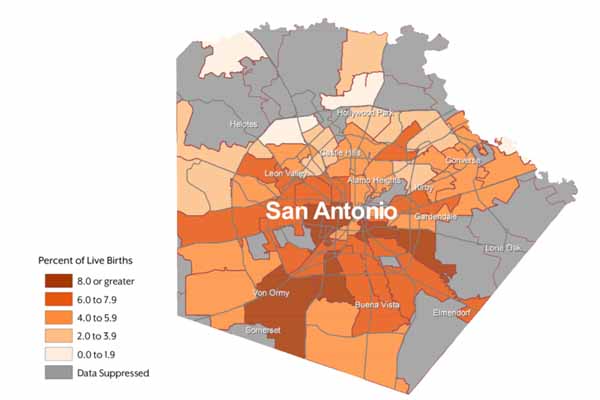
You can learn a lot from a ZIP code.
The five-digit number is more than just a postal code or geographic location. For medicine, a ZIP code can predict how likely someone will contract cancer or diabetes — or even help calculate someone’s potential lifespan. It can also show where pregnant women in Texas face the greatest health risks, according to a new study by The University of Texas System and UT Health Science Center at Tyler.
The study highlights some of the most important risk factors facing new moms: smoking during pregnancy, pre-pregnancy obesity, and use of prenatal care. It’s based on 2013-2015 birth records and includes a variety of searchable online maps.
"As Texas moves forward with efforts to improve maternal health, it is important that we understand how some of the key risk factors vary widely even within cities," said David Lakey, MD, vice chancellor for health affairs and chief medical officer for UT System. "This will allow us to target efforts where they're most needed."
For instance, the interactive maps show that in the Fort Worth ZIP code 76164, which includes the Stockyards, pre-pregnancy obesity is at 28.7 percent, and 10.4 percent of mothers reported no prenatal care. But in adjoining ZIP code 76107, which includes expensive neighborhoods like Westover Hills, the obesity rate is 16.8 percent, and only 3.3 percent of mothers reported no prenatal care.
"These measures also offer a window into the health status of the entire community," the report says, "as mothers are a subset of the larger population."
Texas’ high maternal mortality and illness rate has long been a concern of the Texas Medical Association and the TMA-supported Texas Maternal Mortality and Morbidity Task Force.
In 2012, Texas’ maternal mortality rate was between 14.6 and 18.6 deaths per 100,000, while the national average was 15.9 per 100,000.
White women in Texas overall have a maternal death rate of 13.6 per 100,000 live births, but the rate for African-American Texans is 27.8, according to research by the Texas Maternal Mortality and Morbidity Task Force. And for every death, there are an estimated 20 to 50 cases of severe maternal illness regardless of race, Dr. Lakey says.
The UT study, which includes only ZIP codes with 100 or more births, breaks down the data by race and ethnicity. And by focusing on individual ZIP codes, the research provides insight into specific communities.
In Bexar County (which includes San Antonio) for example, live births to Hispanic women who were classified as morbidly obese before becoming pregnant ranged from 1.1 percent to 9.3 percent, the study says. For whites, they ranged from 1.4 percent to 9.4 percent, and for African Americans, they ranged from 3.6 percent to 6.8 percent.
The study follows up on a similar report in January by the UT Health Science Center at Tyler that looked at infant mortality.
"There is no silver bullet for improving maternal health in Texas," Dr. Lakey said. "What’s required are a range of approaches, informed by data and evidence. This work is intended to assist these efforts."